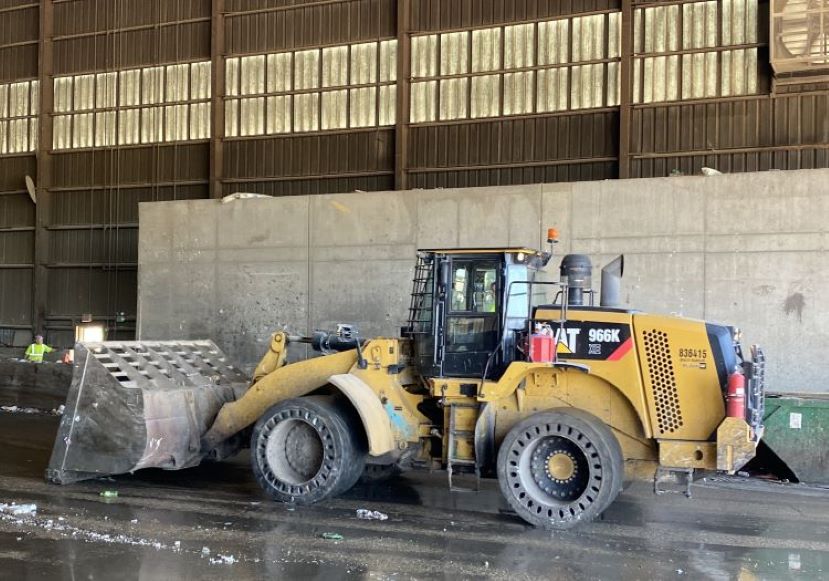Where Does Our Waste Go?
Recycling:
The truck that collects recycling from your bin takes its load to a facility called a transfer station (see orange truck icons on map below for locations). Transfer stations usually accept both garbage and recycling but by law they must be kept separate and never mixed together. Transfer stations have either separate bays or completely separate buildings for trash and recycling. Then, recycling is loaded into larger, more efficient trucks for longer-distance transport.

A front end loader at a local transfer station
Large trucks take recyclables to facilities called materials recovery facilities (in the industry, we call them MRFs, pronounced “murf"). Material recovery facilities are essentially factories that specialize in separating single stream recycling into bales containing only one material. There are several MRFs serving the greater Chicago region (see blue recycle symbol icons on map below for locations). MRFs vary in technology and processes, but most if not all MRFs in this area use sophisticated technology, including infra-red sorters and AI-enabled robots, to sort recyclables. Each of the three largest haulers serving Kane County opened a new MRF in the Chicago region within the last 5 years. MRFs also employ many people to do some initial sorting and to perform quality control. Check out the video below by the waste company LRS for a look inside a Chicago-area MRF.
The outputs of MRFs are large bales made of ideally just one material. Plastics are baled by type (PET - #1, polyethylene - #2, polypropylene - #5). Mixed paper and corrugated cardboard are baled separately. Aluminum and steel are baled separately. Glass is not baled, but is collected in large hoppers for transport. The bales are sold on the commodity market to buyers who use the materials to make new items. Contamination (called "residuals" in industry speak) is another unfortunate product of MRFs. Generally, anywhere from 20 - 35% of material brought to a MRF is not recyclable. This material ideally goes in one end of the MRF and out the other. It is sent to a landfill.

The Kane County Recycling Coordinator poses with some bales of aluminum and HDPE (plastic #2) sorted at a Chicago-area MRF
Transfer Stations, MRFs, Compost Facilities and Landfills serving Kane County Waste Needs
(click "four corners" icon in top right to open in a new tab)
Trash:
The truck that collects trash from your bin takes its load to a facility called a transfer station (see orange truck icons on map above for locations). Transfer stations usually accept both and recycling but by law they must be kept separate and never mixed together. Transfer stations have either separate bays or completely separate buildings for trash and recycling. Trash at the transfer station is compressed and loaded into larger, more efficient trucks for longer-distance transport. These larger trucks take the material to landfills. Virtually all municipal solid waste in Illinois currently landfilled, not incinerated. There is no longer an active landfill in Kane County, so our trash is transported either west or south (see maroon trash can icons on map above for locations).
Separated Yard Waste/Organics:
The truck that collects yard waste or mixed organics from your home may take its load to a facility called a transfer station (see orange truck icons on map above for locations). A transfer station that allows yard waste must keep that material separate from trash or recycling. Some haulers send their yard waste collection trucks directly to compost facilities, bypassing transfer.
A truck delivers a load of yard waste to an area compost facility
There are several IEPA permitted yard waste compost facilities in and around Kane County that accept the material (see green point icons on map above). These facilities are allowed to take up to 10% food scrap by weight under their current permits. This allowance has resulted in some municipal waste programs that allow residents to mix certain food scraps in with yard waste. However, because most of the material processed by these facilities is yard waste, they are generally only open seasonally, early April through the end of November. Some may reopen briefly to process Christmas trees. Yard waste compost facilities grind or chip large woody material into mulch. They also grind up the other organic material and arrange it into long banks called windrows, where it decomposes into compost. These facilities also sell bulk mulch and compost for use in construction projects, landscaping and home gardens.
Black gold! The result of commercial scale composting is a soil amendment that's good for farm fields and gardens
Compost facilities that take more than 10% food scrap are required to be permitted by IEPA as Pollution Control Facilities. There are no fully permitted compost facilities in or very close to Kane County, which unfortunately limits food scrap composting options.